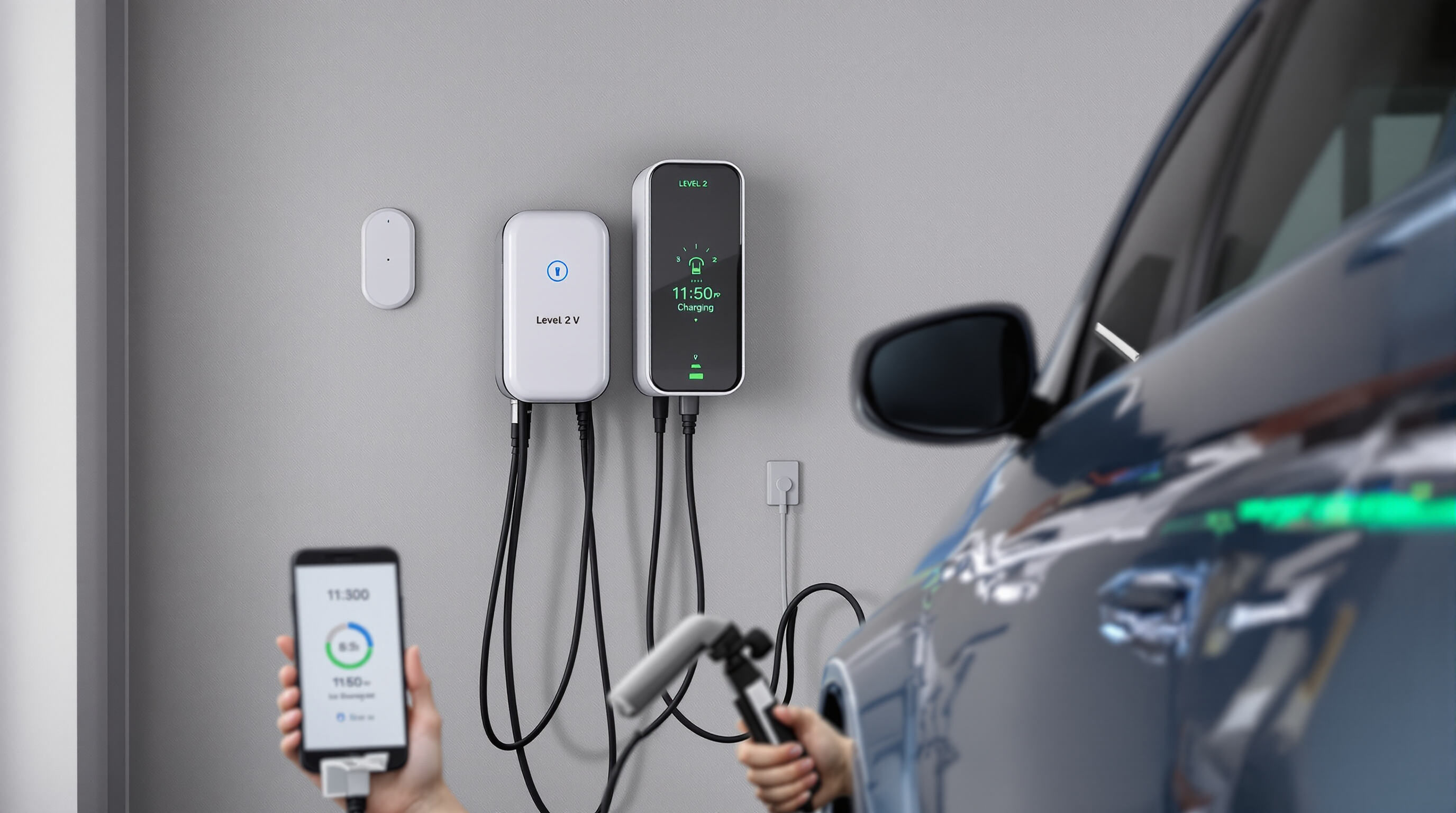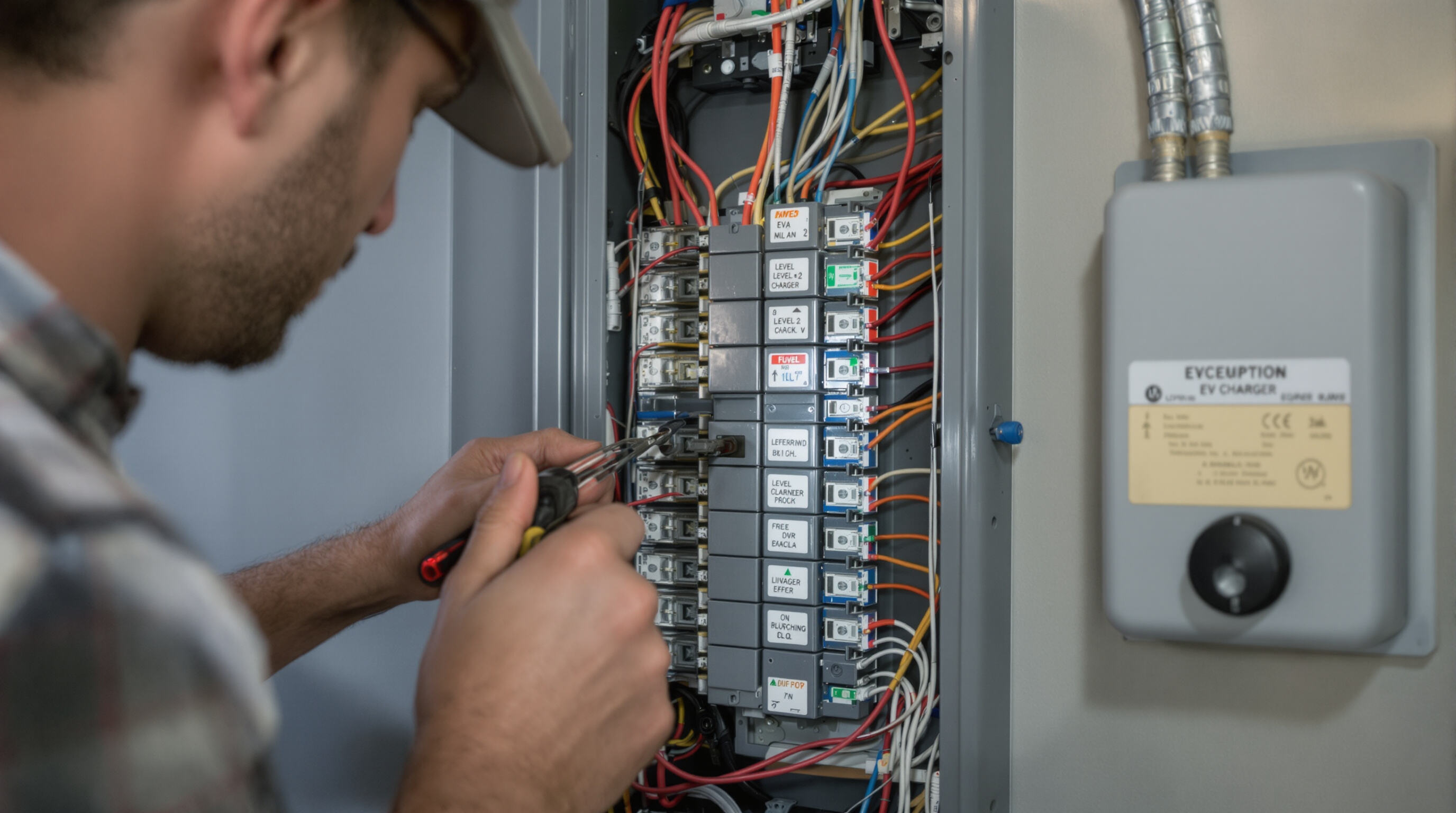Understanding Your Home Charging Needs and Options
The Role of EV Chargers in Daily Electric Vehicle Ownership
Home EV chargers simplify vehicle ownership by enabling convenient overnight charging, reducing dependence on public stations for daily use. Most drivers achieve a full charge each morning through scheduled sessions, especially when leveraging smart features that align with off-peak electricity rates.
Level 1 vs Level 2 Chargers: Key Differences for Home Charging
The first level of EV charging works with regular household 120V outlets and gives about 3 to 5 extra miles every hour of charging time. These are fine for people who drive hybrid cars most days or only need to top up occasionally. Then there's Level 2 charging which needs a special 240V circuit but makes a big difference. It charges around 5 to 7 times quicker than Level 1, so drivers can get 25 to 30 miles added each hour. According to the latest report from Consumer Reports in 2024, most homeowners going electric opt for Level 2 setups because they strike just the right middle ground between how fast they charge (typically taking 6 to 8 hours for a full battery) and what they cost to install somewhere between $500 and $2,000 total.
Charging Power and Amperage Explained
EV charger performance depends on amperage:
| Amperage | Charging Speed | Typical Circuit |
|---|---|---|
| 32A | 25–30 mph | 40-amp breaker |
| 40A | 30–35 mph | 50-amp breaker |
| 48A | 35–45 mph | 60-amp breaker |
Higher-amperage models require professional evaluation, as 48A chargers need dedicated 60-amp circuits that may exceed the capacity of older homes. Proper load calculations prevent overloads and ensure efficient charging.
Evaluating Key Features of Level 2 EV Chargers for Home Use

Why Most Homeowners Prefer Level 2 EV Chargers for Home Use
Most people who live at home go for Level 2 chargers because they just work better for daily needs. The regular Level 1 option barely gives 3 to 5 extra miles every hour, while Level 2 can boost range by anywhere from 15 up to 60 miles an hour. That means going from empty to full takes around 6 to 8 hours instead of waiting over 30 hours straight. According to recent surveys, something like 8 out of 10 American homeowners have settled on Level 2 installations since they charge much quicker and save money in the long run. Many units come with settings that let users adjust amperage between 32A and 48A depending on what kind of electrical setup their house actually has available.
Smart Charger Features for Optimized Usage
Modern Level 2 chargers include smart technology to improve energy efficiency. Key features include:
- Energy tracking to monitor usage and align with off-peak utility rates
- Access control via RFID or mobile apps to prevent unauthorized use
-
Scheduling to optimize charging during low-demand periods or when solar generation is high
Advanced models support automatic load balancing, adjusting power delivery during peak household use to avoid circuit overloads.
Smart Charging Features and App Integration for Remote Monitoring and Automation
Chargers that connect to apps let people control them from their phones remotely. Users can actually start or stop charging sessions whenever they want, get notifications when things happen, and even tweak how fast the car charges depending on electricity prices at different times of day. A few newer models work right alongside home solar setups too, so extra power generated during sunny days gets used to fill up the battery instead of going to waste. All this automated stuff makes the whole process way more efficient. Plus it plays nicely with other smart home devices, which means Level 2 chargers aren't just convenient gadgets anymore but rather essential components in today's increasingly interconnected households.
Ensuring Compatibility with Your Vehicle and Electrical System
Compatibility with J1772 and NACS Connectors Across Major EV Models
The majority of electric vehicles in North America rely on either the J1772 connector for Level 1 and 2 charging or the NACS standard which was initially created by Tesla. Around 95 percent of EVs not made by Tesla still feature J1772 ports, though many recent models from manufacturers like Ford and General Motors are starting to incorporate NACS as well. Before purchasing any charging equipment, it's important to check what kind of port your specific car has and make sure whatever charger you get works with that particular system. Some owners might find themselves stuck if they don't match these standards correctly.
Charger Compatibility with EV Models and Future-Proofing Your Investment
Ensure your charger supports future vehicle upgrades. Older 32A units may not meet the demands of next-generation EVs capable of 48A charging. Opt for chargers certified to SAE J1772 standards and compatible with both 208V and 240V systems to maintain flexibility for future EV purchases.
Cord Length Considerations for Garage Setup and Ease of Access
A 20-foot cord offers greater flexibility for various parking positions and charging port locations, while 15-foot cords suit compact garages. Mount the charger about 7 feet above ground to reduce tripping risks and manage slack. Avoid tight coiling, which can shorten cable lifespan by up to 30% (National Renewable Energy Lab 2022).
Assessing Home Electrical Infrastructure and Installation Requirements

Proper electrical infrastructure is essential for safe and efficient EV charging. A 2023 Department of Energy study found that 62% of residential EV charging issues stem from inadequate electrical preparation, underscoring the need for a thorough system assessment before installation.
Electrical Panel Capacity and Potential Upgrades for Safe EV Charger Installation
Most homes need a 200-amp electrical panel to support Level 2 chargers drawing 40–50 amps. Key considerations include:
- Load Calculation: Licensed electricians assess total household demand, including major appliances, against the charger’s 7.7–11.5 kW load
- Upgrade Costs: Panel upgrades typically range from $1,200–$4,000, depending on local codes and labor
- Future-Proofing: Installing a 60-amp circuit prepares your home for future EVs with larger batteries (80–100 kWh)
Home Electrical Infrastructure Requirements for EV Charging: Voltage, Circuit, and Load
Level 2 chargers require dedicated 240V circuits compliant with NEC Article 625. Recommended specifications:
| Parameter | Minimum Requirement | Optimal Setup |
|---|---|---|
| Circuit Capacity | 40A (9.6 kW) | 50A (12 kW) |
| Wire Gauge | 8 AWG (copper) | 6 AWG (copper) |
| Breaker Type | Double-pole GFCI | Smart circuit monitor |
Hardwired vs Plug-In EV Charger Installations: Safety, Cost, and Flexibility
Hardwired installations reduce fire risk by 34% (UL Solutions), as they eliminate wear-prone plug connections. However, plug-in units offer advantages:
- Safety: Hardwired systems avoid connector degradation (NEMA 14-50 plugs wear after ~500 cycles)
- Cost: Plug-in setups save $300–$600 in labor
-
Mobility: Easier to relocate during renovations or changes in parking patterns
Check local regulations—73% of U.S. municipalities now require professional certification for EV charger installations.
Cost, Incentives, and Long-Term Value of Home EV Charger Installation
Upfront and Long-Term Costs of Installing an EV Charger at Home
Installation costs typically range from $500–$2,500, depending on charger specifications and electrical upgrades. Level 2 systems (7–11 kW) average $1,200–$2,000 with professional installation, though simpler setups may cost under $1,000. Long-term savings come from avoiding public charging, where rates are 30–50% higher per kWh than residential electricity.
Federal and Local Incentives for Home EV Charger Installation
The federal tax credit covers 30% of installation costs (up to $1,000) through 2032. Additionally, 23 states offer rebates—such as California’s $1,500 Clean Fuel Reward. A 2025 European incentive study found that 68% of homeowners combined regional grants and utility discounts to cut upfront costs by 40–60%.
Return on Investment Through Reduced Fuel and Maintenance Expenses
EV owners save $1,000–$1,500 annually compared to gasoline vehicles, with typical charger installations paying for themselves in 4–6 years. Battery-electric vehicles also require 40% less maintenance than internal combustion engines, saving over $3,000 in service costs by 100,000 miles (Argonne National Lab).
FAQs
What is the difference between Level 1 and Level 2 EV chargers?
Level 1 chargers use standard 120V household outlets and provide 3 to 5 miles of range per hour of charging, while Level 2 chargers require special 240V circuits and offer 25 to 30 miles of range per hour. Level 2 units charge faster and are more suitable for daily use.
Can I install a Level 2 charger at home?
Yes, many homeowners opt for Level 2 chargers due to their faster charging capability. Installation typically requires a dedicated 240V circuit and may necessitate upgrading your electrical panel if it doesn't meet the amperage requirements.
Are there any incentives for installing a home EV charger?
Yes, there are federal tax credits covering up to 30% of installation costs (up to $1,000) through 2032. Additionally, some states offer rebates, such as the $1,500 Clean Fuel Reward in California.
How can smart features in EV chargers optimize usage?
Smart features include energy tracking, access control, and scheduling. They help optimize charging during off-peak periods, monitor energy usage, and prevent unauthorized access, contributing to long-term savings.
What connector standards should I consider for my EV charger?
Most EVs in North America use the J1772 connector for Level 1 and 2 charging or the NACS standard used by Tesla. Ensure your charger's compatibility with these standards for hassle-free charging.
Table of Contents
- Understanding Your Home Charging Needs and Options
- Evaluating Key Features of Level 2 EV Chargers for Home Use
- Ensuring Compatibility with Your Vehicle and Electrical System
- Assessing Home Electrical Infrastructure and Installation Requirements
- Cost, Incentives, and Long-Term Value of Home EV Charger Installation
- FAQs

